Evaluating Capability of Green Stormwater Infrastructure on Large Properties toward Adaptive Flood Mitigation: The HLCA+C Methodology
Abstract
:1. Introduction
Existing Methodologies for Modelling Flood Mitigation Capability
2. Hydrology-based Land Capability Assessment and Classification (HLCA+C) Methodology
2.1. Step 1: Cluster Properties into SWM Zone for Capability Analysis
2.2. Step 2: Quantify Collectable Runoff Volumes within Each SWM Zone
2.2.1. Sub-Step 2.1: Calculation of Runoff Volumes
2.2.2. Sub-Step 2.2: Estimation of Potential in-Ground Storage Capacities
2.2.3. Sub-Step 2.3: Quantification of Maximum Collectable Runoff Volume
2.3. Step 3: Evaluate SWM Zone Flood Mitigation Capability (FMC)
2.4. Step 4: Classify SWM Zones to Identify GSI Implementation Approaches and Priority Zones for Adaptive GSI Network Development
2.4.1. Sub-Step 4.1: Classification of Zones by Their FMCs and Key Limiting Factors
2.4.2. Sub-Step 4.2: Identification of GSI Implementation Approach and Prioritisation of SWM Zones for GSI Networks
3. Discussion and Conclusions
Limitations of the HLCA+C Methodology
Author Contributions
Funding
Acknowledgments
Conflicts of Interest
References
- Dedekorkut-Howes, A.; Torabi, E.; Howes, M. When the tide gets high: A review of adaptive responses to sea level rise and coastal flooding. J. Environ. Plan. Manag. 2020, 63, 2102–2143. [Google Scholar] [CrossRef]
- Yousefpour, R.; Hanewinkel, M. Climate change and decision-making under uncertainty. Curr. For. Rep. 2016, 2, 143–149. [Google Scholar] [CrossRef] [Green Version]
- Terry, J.P.; Winspear, N.; Goff, J. Is Bangkok at risk of marine flooding? Evidence relating to the historical floods of AD 1785 and 1983. Nat. Hazards 2021, 105, 1013–1030. [Google Scholar] [CrossRef]
- Adnan, M.S.G.; Abdullah, A.Y.M.; Dewan, A.; Hall, J.W. The effects of changing land use and flood hazard on poverty in coastal Bangladesh. Land Use Policy 2020, 99, 104868. [Google Scholar] [CrossRef]
- Martel, J.-L.; Brissette, F.P.; Lucas-Picher, P.; Troin, M.; Arsenault, R. Climate Change and Rainfall Intensity-Duration-Frequency Curves: Overview of Science and Guidelines for Adaptation. J. Hydrol. Eng. 2021, 26, 03121001. [Google Scholar] [CrossRef]
- Vitousek, S.; Barnard, P.L.; Fletcher, C.H.; Frazer, N.; Erikson, L.; Storlazzi, C.D. Doubling of coastal flooding frequency within decades due to sea-level rise. Sci. Rep. 2017, 7, 1399. [Google Scholar] [CrossRef] [Green Version]
- Davtalab, R.; Mirchi, A.; Harris, R.J.; Troilo, M.X.; Madani, K. Sea level rise effect on groundwater rise and stormwater retention pond reliability. Water 2020, 12, 1129. [Google Scholar] [CrossRef] [Green Version]
- Befus, K.M.; Barnard, P.L.; Hoover, D.J.; Finzi Hart, J.A.; Voss, C.I. Increasing threat of coastal groundwater hazards from sea-level rise in California. Nat. Clim. Chang. 2020, 10, 946–952. [Google Scholar] [CrossRef]
- Bagheri-Gavkosh, M.; Hosseini, S.M.; Ataie-Ashtiani, B.; Sohani, Y.; Ebrahimian, H.; Morovat, F.; Ashrafi, S. Land subsidence: A global challenge. Sci. Total Environ. 2021, 778, 146193. [Google Scholar] [CrossRef]
- Chan, F.K.S.; Chuah, C.J.; Ziegler, A.D.; Dąbrowski, M.; Varis, O. Towards resilient flood risk management for Asian coastal cities: Lessons learned from Hong Kong and Singapore. J. Clean. Prod. 2018, 187, 576–589. [Google Scholar] [CrossRef]
- Brown, S.; Jenkins, K.; Goodwin, P.; Lincke, D.; Vafeidis, A.T.; Tol, R.S.J.; Jenkins, R.; Warren, R.; Nicholls, R.J.; Jevrejeva, S.; et al. Global costs of protecting against sea-level rise at 1.5 to 4.0 °C. Clim. Chang. 2021, 167, 4. [Google Scholar] [CrossRef]
- Radhakrishnan, M.; Pathirana, A.; Ashley, R.M.; Gersonius, B.; Zevenbergen, C. Flexible adaptation planning for water sensitive cities. Cities 2018, 78, 87–95. [Google Scholar] [CrossRef]
- Lawrence, J.; Stephens, S.; Blackett, P.; Bell, R.G.; Priestley, R. Climate Services Transformed: Decision-Making Practice for the Coast in a Changing Climate. Front. Mar. Sci. 2021, 8, 703902. [Google Scholar] [CrossRef]
- Haasnoot, M.; Kwakkel, J.H.; Walker, W.E.; ter Maat, J. Dynamic adaptive policy pathways: A method for crafting robust decisions for a deeply uncertain world. Glob. Environ. Chang. 2013, 23, 485–498. [Google Scholar] [CrossRef] [Green Version]
- McPhillips, L.E.; Matsler, A.M. Temporal Evolution of Green Stormwater Infrastructure Strategies in Three US Cities. Front. Built Environ. 2018, 4, 26. [Google Scholar] [CrossRef] [Green Version]
- Zahmatkesh, Z.; Karamouz, M. An uncertainty-based framework to quantifying climate change impacts on coastal flood vulnerability: Case study of New York City. Environ. Monit. Assess. 2017, 189, 567. [Google Scholar] [CrossRef]
- Dudula, J.; Randhir, T.O. Modeling the influence of climate change on watershed systems: Adaptation through targeted practices. J. Hydrol. 2016, 541, 703–713. [Google Scholar] [CrossRef] [Green Version]
- Kim, H.; Jung, M.; Mallari, K.J.B.; Pak, G.; Kim, S.; Kim, S.; Kim, L.; Yoon, J. Assessment of porous pavement effectiveness on runoff reduction under climate change scenarios. Desalination Water Treat. 2015, 53, 3142–3147. [Google Scholar] [CrossRef]
- Zahmatkesh, Z.; Burian, S.J.; Karamouz, M.; Tavakol-Davani, H.; Goharian, E. Low-Impact Development Practices to Mitigate Climate Change Effects on Urban Stormwater Runoff: Case Study of New York City. J. Irrig. Drain. Eng. 2015, 141, 04014043. [Google Scholar] [CrossRef]
- Muangsri, S.; McWilliam, W.; Davies, T.; Urlich, S.C. Supplemental Coastal City Flood Mitigation: The Untapped Potential of Retrofitting Industrial Land with Green Stormwater Infrastructure; Lincoln University: Lincoln, New Zealand, 2022; manuscript to be submitted. [Google Scholar]
- O’Donnell, E.C.; Lamond, J.E.; Thorne, C.R. Recognising barriers to implementation of Blue-Green Infrastructure: A Newcastle case study. Urban Water J. 2017, 14, 964–971. [Google Scholar] [CrossRef]
- Fluhrer, T.; Chapa, F.; Hack, J. A Methodology for Assessing the Implementation Potential for Retrofitted and Multifunctional Urban Green Infrastructure in Public Areas of the Global South. Sustainability 2021, 13, 384. [Google Scholar] [CrossRef]
- Aparicio Uribe, C.H.; Bonilla Brenes, R.; Hack, J. Potential of retrofitted urban green infrastructure to reduce runoff—A model implementation with site-specific constraints at neighborhood scale. Urban For. Urban Green. 2022, 69, 127499. [Google Scholar] [CrossRef]
- Smith, B.K.; Smith, J.A.; Baeck, M.L.; Miller, A.J. Exploring storage and runoff generation processes for urban flooding through a physically based watershed model. Water Resour. Res. 2015, 51, 1552–1569. [Google Scholar] [CrossRef]
- Boon, E.; Goosen, H.; Van Veldhoven, F.; Swart, R. Does transformational adaptation require a transformation of climate services? Front. Clim. 2021, 3, 2. [Google Scholar] [CrossRef]
- Golden, H.E.; Hoghooghi, N. Green infrastructure and its catchment-scale effects: An emerging science. WIREs Water 2018, 5, e1254. [Google Scholar] [CrossRef] [Green Version]
- Gopalakrishnan, C.; Okada, N. Reflections on Implementation Science. J. Nat. Resour. Policy Res. 2012, 4, 79–88. [Google Scholar] [CrossRef]
- Kirshen, P.; Caputo, L.; Vogel, R.M.; Mathisen, P.; Rosner, A.; Renaud, T. Adapting Urban Infrastructure to Climate Change: A Drainage Case Study. J. Water Resour. Plan. Manag. 2015, 141, 04014064. [Google Scholar] [CrossRef] [Green Version]
- Joyce, J.; Chang, N.-B.; Harji, R.; Ruppert, T.; Imen, S. Developing a multi-scale modeling system for resilience assessment of green-grey drainage infrastructures under climate change and sea level rise impact. Environ. Model. Softw. 2017, 90, 1–26. [Google Scholar] [CrossRef]
- Gao, J.; Wang, R.; Huang, J.; Liu, M. Application of BMP to urban runoff control using SUSTAIN model: Case study in an industrial area. Ecol. Model. 2015, 318, 177–183. [Google Scholar] [CrossRef]
- Jayasooriya, V.M.; Muthukumaran, S.; Ng, A.W.M.; Perera, B.J.C. Multi Criteria Decision Making in Selecting Stormwater Management Green Infrastructure for Industrial areas Part 2: A Case Study with TOPSIS. Water Resour. Manag. 2018, 32, 4297–4312. [Google Scholar] [CrossRef]
- Voskamp, I.M.; Van de Ven, F.H.M. Planning support system for climate adaptation: Composing effective sets of blue-green measures to reduce urban vulnerability to extreme weather events. Build. Environ. 2015, 83, 159–167. [Google Scholar] [CrossRef]
- Bach, P.M.; Kuller, M.; McCarthy, D.T.; Deletic, A. A spatial planning-support system for generating decentralised urban stormwater management schemes. Sci. Total Environ. 2020, 726, 138282. [Google Scholar] [CrossRef] [PubMed]
- Kuller, M.; Bach, P.M.; Roberts, S.; Browne, D.; Deletic, A. A planning-support tool for spatial suitability assessment of green urban stormwater infrastructure. Sci. Total Environ. 2019, 686, 856–868. [Google Scholar] [CrossRef] [PubMed]
- Li, L.; Uyttenhove, P.; Van Eetvelde, V. Planning green infrastructure to mitigate urban surface water flooding risk—A methodology to identify priority areas applied in the city of Ghent. Landsc. Urban Plan. 2020, 194, 103703. [Google Scholar] [CrossRef]
- Omitaomu, O.A.; Kotikot, S.M.; Parish, E.S. Planning green infrastructure placement based on projected precipitation data. J. Environ. Manag. 2021, 279, 111718. [Google Scholar] [CrossRef]
- Lyle, J.T. Design for Human Ecosystems: Landscape, Land Use, and Natural Resources; Island Press: Washington, DC, USA, 1999. [Google Scholar]
- IPCC. Summary for Policymakers. In Climate Change 2022: Impacts, Adaptation, and Vulnerability. Contribution of Working Group II to the Sixth Assessment Report of the Intergovernmental Panel on Climate Change; Pörtner, H.-O., Roberts, D.C., Poloczanska, E.S., Mintenbeck, K., Tignor, M., Alegría, A., Craig, M., Langsdorf, S., Löschke, S., Möller, V., et al., Eds.; Cambridge University Press: Cambridge, UK, 2022. [Google Scholar]
- IPCC. Summary for Policymakers. In Climate Change 2013—The Physical Science Basis: Working Group I Contribution to the Fifth Assessment Report of the Intergovernmental Panel on Climate Change; Intergovernmental Panel on Climate Change, Ed.; Cambridge University Press: Cambridge, UK, 2014; pp. 1–30. [Google Scholar]
- Thomson, A.M.; Calvin, K.V.; Smith, S.J.; Kyle, G.P.; Volke, A.; Patel, P.; Delgado-Arias, S.; Bond-Lamberty, B.; Wise, M.A.; Clarke, L.E.; et al. RCP4.5: A pathway for stabilization of radiative forcing by 2100. Clim. Chang. 2011, 109, 77. [Google Scholar] [CrossRef] [Green Version]
- Westra, S.; Alexander, L.V.; Zwiers, F.W. Global Increasing Trends in Annual Maximum Daily Precipitation. J. Clim. 2013, 26, 3904–3918. [Google Scholar] [CrossRef] [Green Version]
- Paul, P.K.; Zhang, Y.; Ma, N.; Mishra, A.; Panigrahy, N.; Singh, R. Selecting hydrological models for developing countries: Perspective of global, continental, and country scale models over catchment scale models. J. Hydrol. 2021, 600, 126561. [Google Scholar] [CrossRef]
- Shu, Y.; Li, H.; Lei, Y. Modelling Groundwater Flow with MIKE SHE Using Conventional Climate Data and Satellite Data as Model Forcing in Haihe Plain, China. Water 2018, 10, 1295. [Google Scholar] [CrossRef] [Green Version]
- Behera, A.K.; Pradhan, R.M.; Kumar, S.; Chakrapani, G.J.; Kumar, P. Assessment of Groundwater Flow Dynamics Using MODFLOW in Shallow Aquifer System of Mahanadi Delta (East Coast), India. Water 2022, 14, 611. [Google Scholar] [CrossRef]
- Chu, Y.; Yang, L.; Wang, X.; Wang, X.; Zhou, Y. Research on Distribution Characteristics, Influencing Factors, and Maintenance Effects of Heavy Metal Accumulation in Bioretention Systems: Critical Review. J. Sustain. Water Built Environ. 2021, 7, 03120001. [Google Scholar] [CrossRef]
- Tedoldi, D.; Chebbo, G.; Pierlot, D.; Kovacs, Y.; Gromaire, M.-C. Impact of runoff infiltration on contaminant accumulation and transport in the soil/filter media of Sustainable Urban Drainage Systems: A literature review. Sci. Total Environ. 2016, 569–570, 904–926. [Google Scholar] [CrossRef] [PubMed]
- Slaney, S. Stormwater Management for Sustainable Urban Environments; Images Publishing Group Pty Limited: Mulgrave, Australia, 2017. [Google Scholar]
- Blick, S.A.; Kelly, F.; Skupien, J.J.; Friedman, B.; Jacobus, S.; McColligan, G.; Birckhead, H.; Morris, J.; Obropta, C.; Schiariti, P.; et al. New Jersey Stormwater Best Management Practices Manual; New Jersey Department of Environmental Protection: Trenton, NJ, USA, 2004. [Google Scholar]
- Northern Virginia Planning District Commission; Engineers Surveyors Institute. Northern Virginia BMP Handbook: A Guide to Planning and Designing Best Management Practices in Northern Virginia; Northern Virginia Planning District Commission: Annandale, VA, USA, 1992. [Google Scholar]
- Hoover, D.J.; Odigie, K.O.; Swarzenski, P.W.; Barnard, P. Sea-level rise and coastal groundwater inundation and shoaling at select sites in California, USA. J. Hydrol. Reg. Stud. 2017, 11, 234–249. [Google Scholar] [CrossRef] [Green Version]
- Plane, E.; Hill, K.; May, C. A Rapid Assessment Method to Identify Potential Groundwater Flooding Hotspots as Sea Levels Rise in Coastal Cities. Water 2019, 11, 2228. [Google Scholar] [CrossRef] [Green Version]
- Kopp, R.E.; Horton, R.M.; Little, C.M.; Mitrovica, J.X.; Oppenheimer, M.; Rasmussen, D.J.; Strauss, B.H.; Tebaldi, C. Probabilistic 21st and 22nd century sea-level projections at a global network of tide-gauge sites. Earth’s Future 2014, 2, 383–406. [Google Scholar] [CrossRef]
- Perrette, M.; Landerer, F.; Riva, R.; Frieler, K.; Meinshausen, M. A scaling approach to project regional sea level rise and its uncertainties. Earth Syst. Dynam. 2013, 4, 11–29. [Google Scholar] [CrossRef] [Green Version]
- Klingebiel, A.A.; Montgomery, P.H. Land-Capability Classification; Soil Conservation Service, US Department of Agriculture: Washington, DC, USA, 1961. [Google Scholar]
- Shafique, M.; Kim, R. Retrofitting the Low Impact Development Practices into Developed Urban areas Including Barriers and Potential Solution. Open Geosci. 2017, 9, 240–254. [Google Scholar] [CrossRef]
- Rogers, B.C.; Bertram, N.; Gersonius, B.; Gunn, A.; Löwe, R.; Murphy, C.; Pasman, R.; Radhakrishnan, M.; Urich, C.; Wong, T.H.F.; et al. An interdisciplinary and catchment approach to enhancing urban flood resilience: A Melbourne case. Philos. Trans. R. Soc. A Math. Phys. Eng. Sci. 2020, 378, 20190201. [Google Scholar] [CrossRef]
- Rosly, D.; Rashid, A.A. Revitalizing urban development in Malaysia through the implementation of urban regeneration programme. In Proceedings of the 43rd Annual Conference of the Urban Affairs Association, San Francisco, CA, USA, 3–6 April 2013; pp. 1–20. [Google Scholar]
- MacGregor, C. Urban regeneration as a public health intervention. J. Soc. Interv. Theory Pract. 2010, 19, 38–51. [Google Scholar] [CrossRef] [Green Version]
- Jaroszewska, E. Urban shrinkage and regeneration of an old industrial city: The case of Wałbrzych in Poland. Quaest. Geogr. 2019, 38, 75–90. [Google Scholar] [CrossRef]
- Rey-Valette, H.; Robert, S.; Rulleau, B. Resistance to relocation in flood-vulnerable coastal areas: A proposed composite index. Clim. Policy 2019, 19, 206–218. [Google Scholar] [CrossRef]
- May, C. Rising groundwater and sea-level rise. Nat. Clim. Chang. 2020, 10, 889–890. [Google Scholar] [CrossRef]
- Doberstein, B.; Fitzgibbons, J.; Mitchell, C. Protect, Accommodate, Retreat or Avoid (PARA): Canadian Community Options for Flood Disaster Risk Reduction and Flood Resilience. Nat. Hazards 2018, 98, 31–50. [Google Scholar] [CrossRef]
- Sivapalan, M.; Blöschl, G. Time scale interactions and the coevolution of humans and water. Water Resour. Res. 2015, 51, 6988–7022. [Google Scholar] [CrossRef] [Green Version]
- Kirshen, P.; Knee, K.; Ruth, M. Climate change and coastal flooding in Metro Boston: Impacts and adaptation strategies. Clim. Chang. 2008, 90, 453–473. [Google Scholar] [CrossRef]
- Acevedo, M.A.; Sefair, J.A.; Smith, J.C.; Reichert, B.; Fletcher, R.J., Jr. Conservation under uncertainty: Optimal network protection strategies for worst-case disturbance events. J. Appl. Ecol. 2015, 52, 1588–1597. [Google Scholar] [CrossRef]
- Hopkins, L.D. Methods for Generating Land Suitability Maps: A Comparative Evaluation. J. Am. Inst. Plan. 1977, 43, 386–400. [Google Scholar] [CrossRef]
- Muangsri, S.; McWilliam, W.; Davies, T.; Lawson, G. How Effective are Strategically Located Green Stormwater Infra-Structure Networks for Adaptive Flood Mitigation in a Context of Climate Change? Land, 2022; submitted. [Google Scholar]
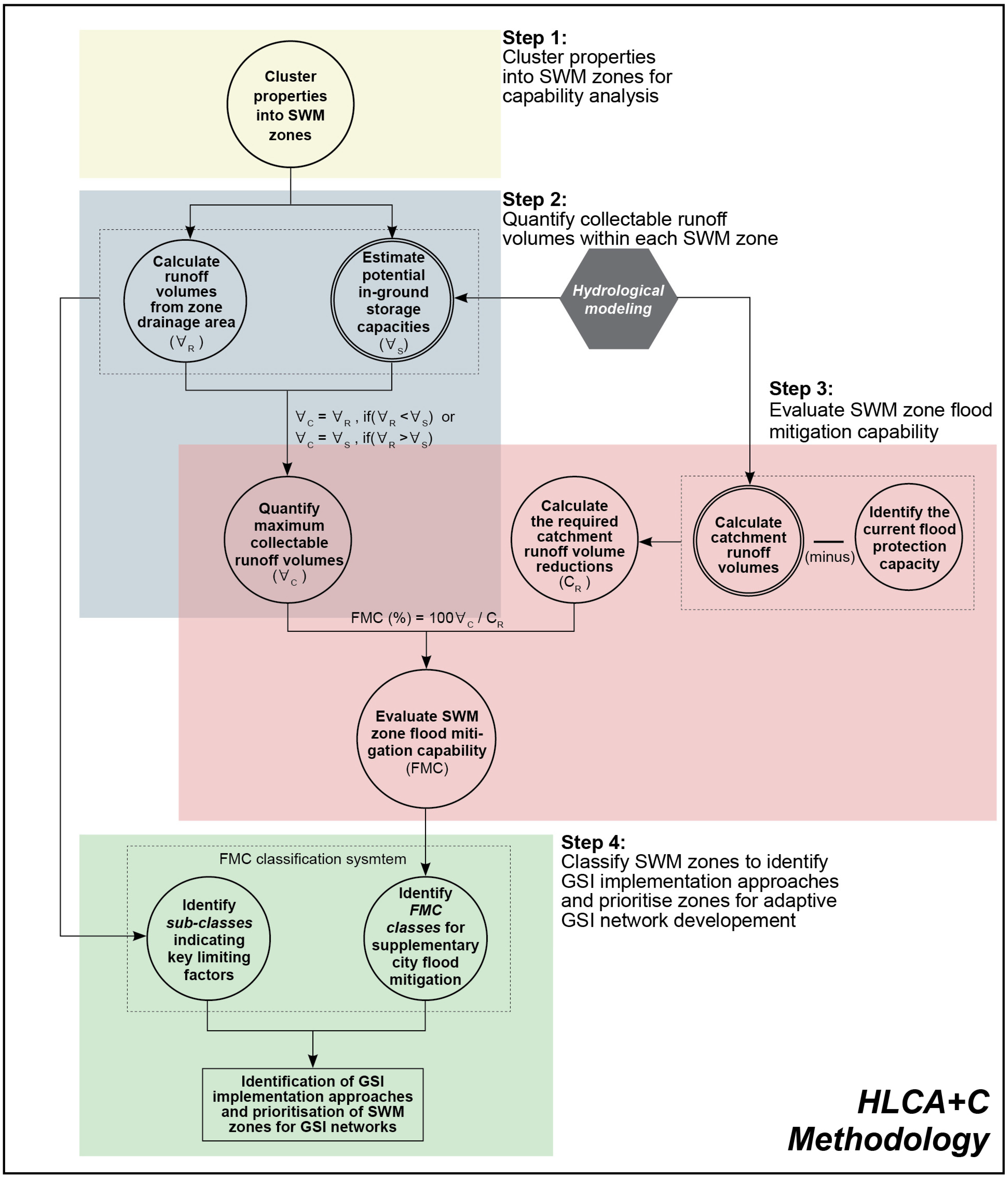

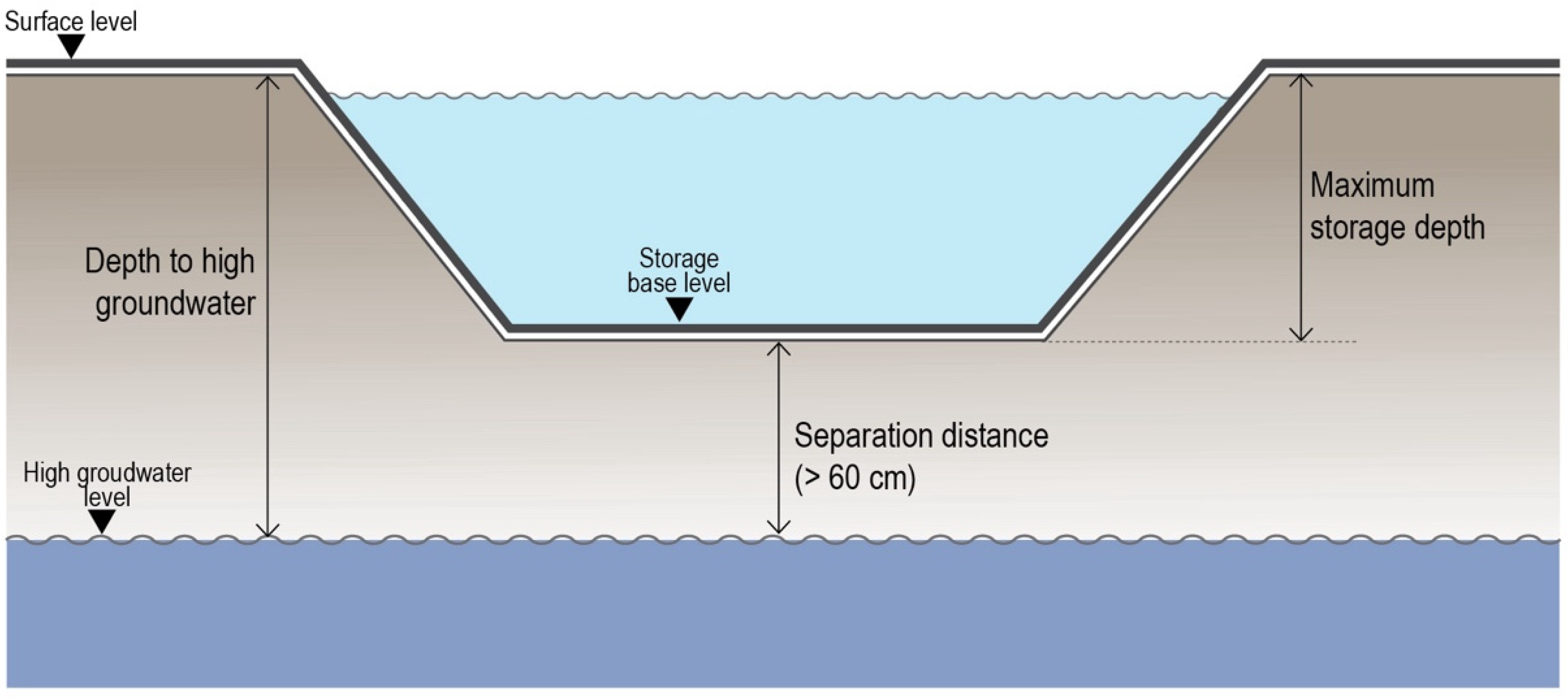
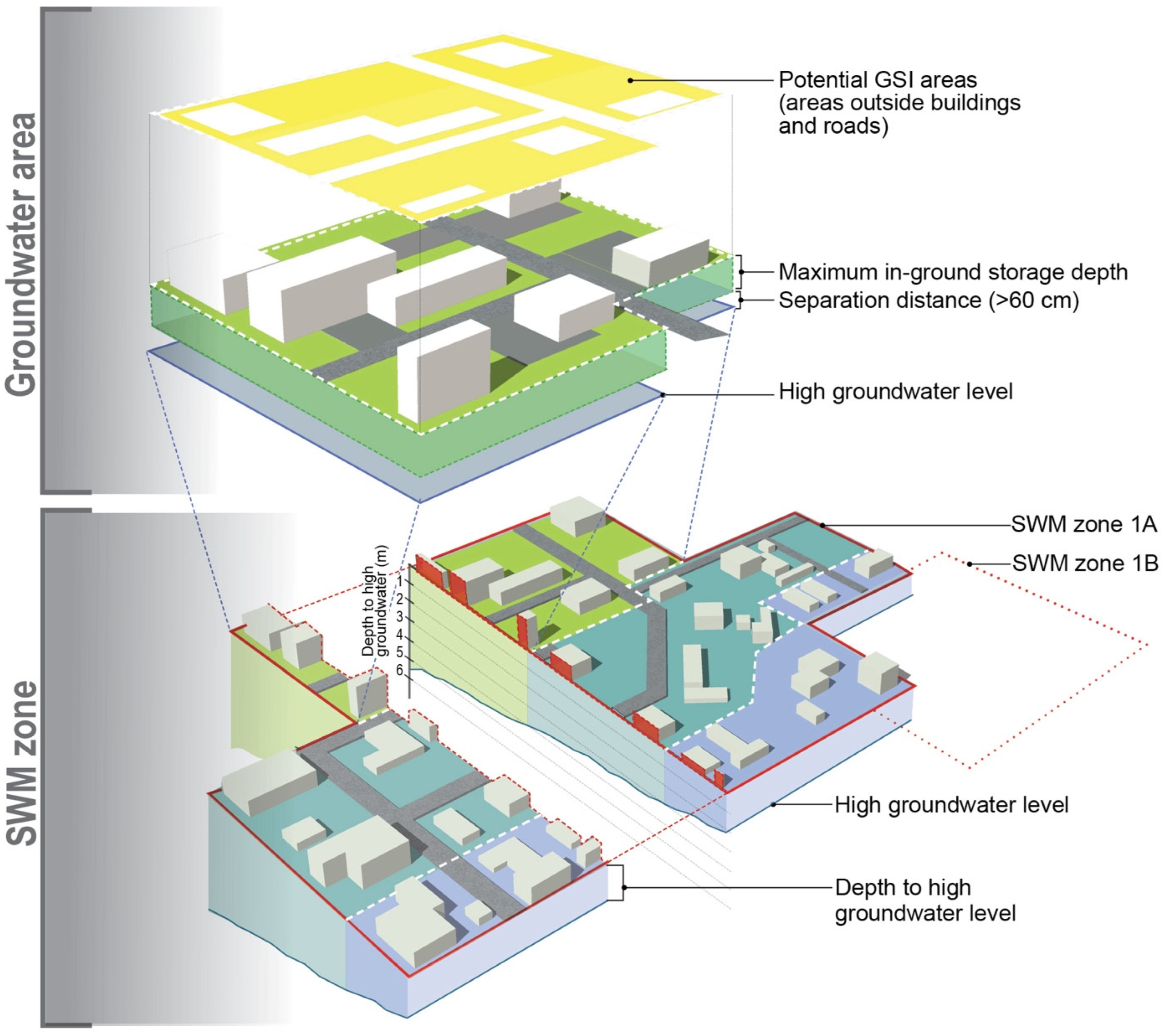
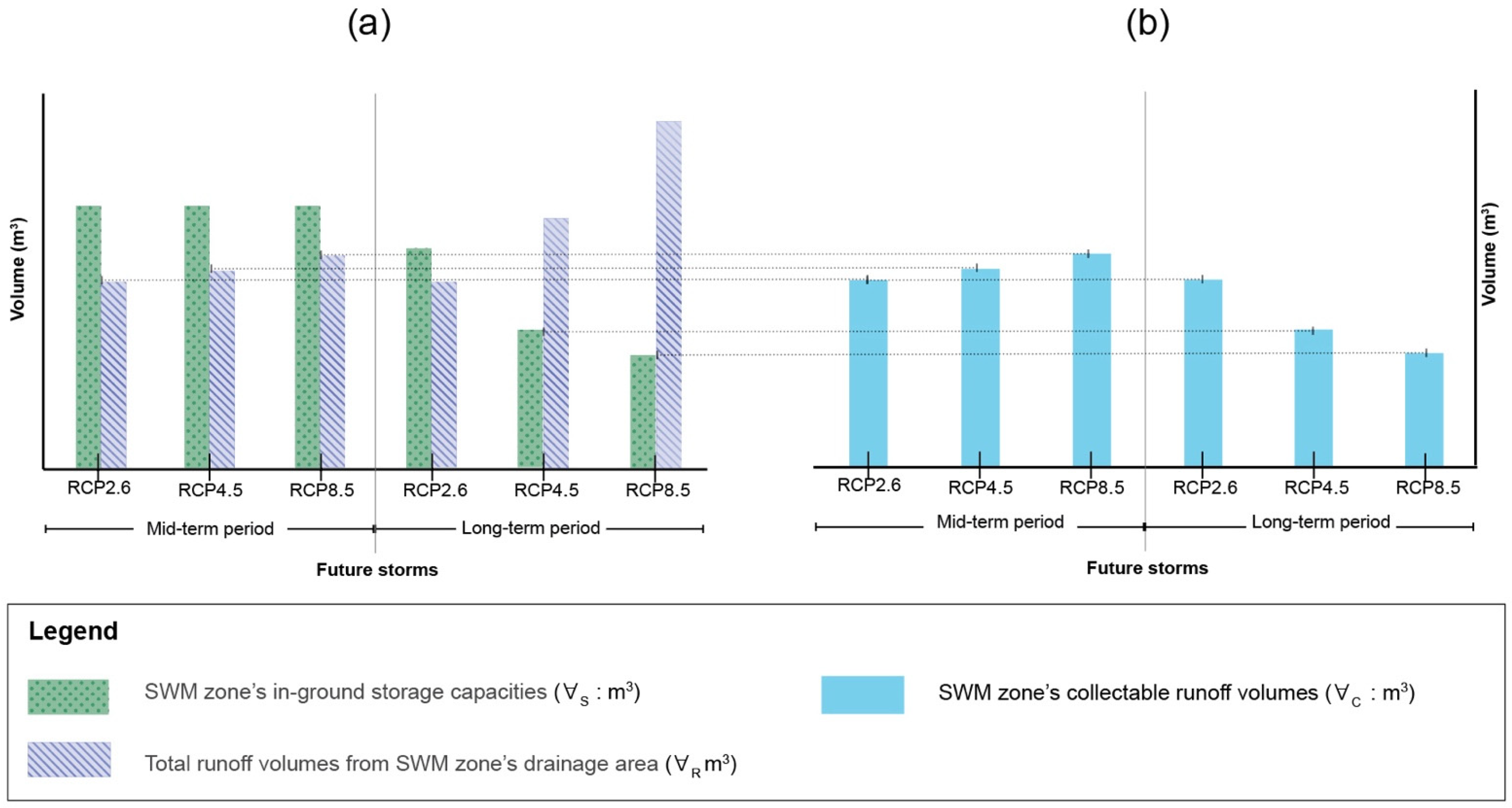

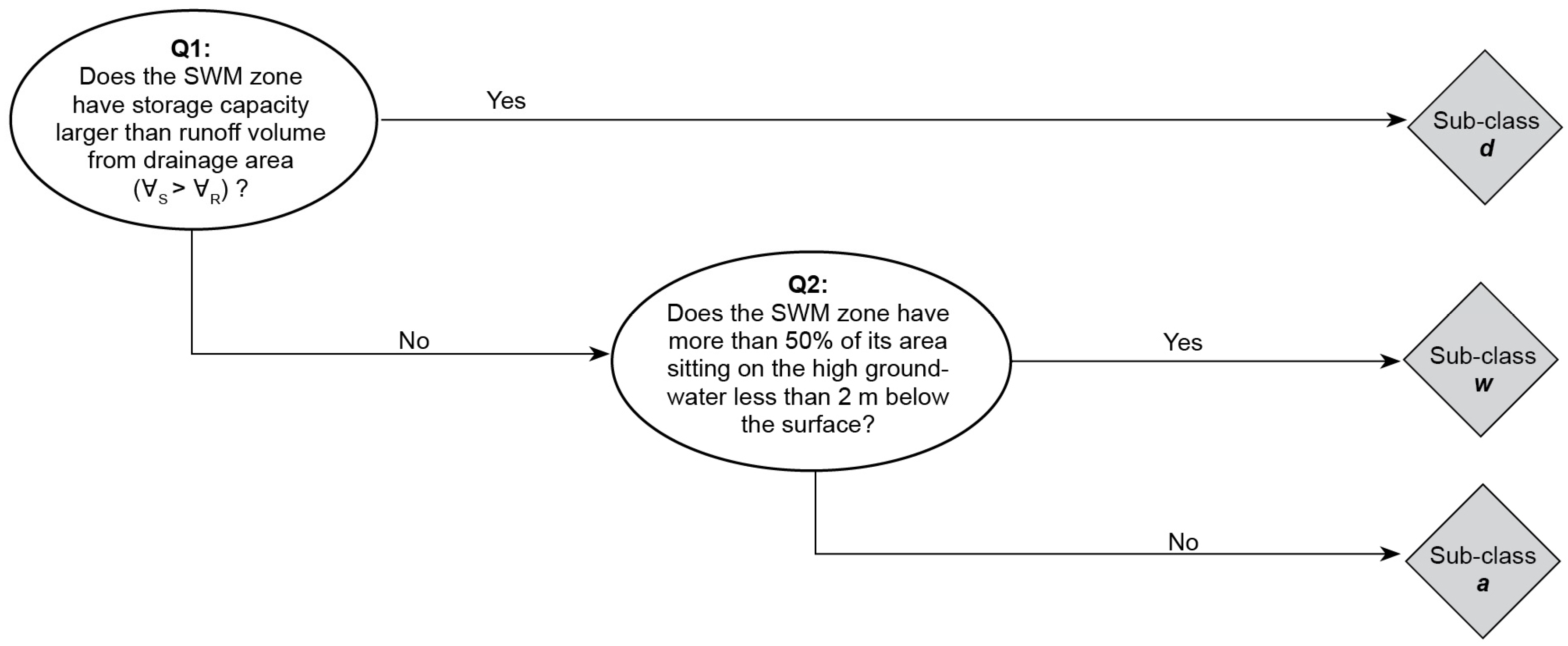

Publisher’s Note: MDPI stays neutral with regard to jurisdictional claims in published maps and institutional affiliations. |
© 2022 by the authors. Licensee MDPI, Basel, Switzerland. This article is an open access article distributed under the terms and conditions of the Creative Commons Attribution (CC BY) license (https://creativecommons.org/licenses/by/4.0/).
Share and Cite
Muangsri, S.; McWilliam, W.; Lawson, G.; Davies, T. Evaluating Capability of Green Stormwater Infrastructure on Large Properties toward Adaptive Flood Mitigation: The HLCA+C Methodology. Land 2022, 11, 1765. https://doi.org/10.3390/land11101765
Muangsri S, McWilliam W, Lawson G, Davies T. Evaluating Capability of Green Stormwater Infrastructure on Large Properties toward Adaptive Flood Mitigation: The HLCA+C Methodology. Land. 2022; 11(10):1765. https://doi.org/10.3390/land11101765
Chicago/Turabian StyleMuangsri, Suphicha, Wendy McWilliam, Gillian Lawson, and Tim Davies. 2022. "Evaluating Capability of Green Stormwater Infrastructure on Large Properties toward Adaptive Flood Mitigation: The HLCA+C Methodology" Land 11, no. 10: 1765. https://doi.org/10.3390/land11101765






